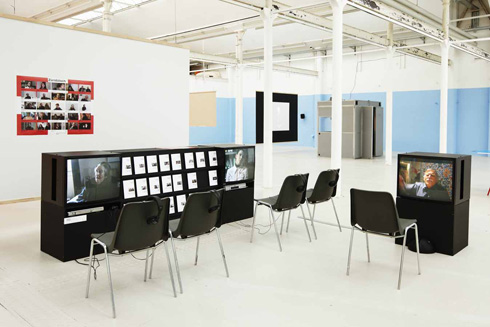 |
Rainer Ganahl

Züridüütsch
Since the beginning of the 1990s, I have been working with languages as part of my art practice. It is in particular language acquisition, language identity and language politics that interest me. Languages define our identity and define us socially. They are part of our network of institutions that form the everyday and that we keep alive, transforming it as we learn, as we work, as we age as we interact and mix culturally. Needless to say, languages are bound by the people and nations that speak them and vice versa. The politics of languages can be very complex and take on absurd twists mirroring cultural, social, and economical as well as racial and religious differences.
Züridüütsch is not equivalent with Swiss German and refers to the way people speak in Zurich. But this is a view only I share for this artwork since many people I talked to try to differentiate speech behaviour situating people geographically “not class specifically“ to places outside the actual city even though a specific person could have lived all his/her life in Switzerland’s biggest city. For this series anybody I have interviewed becomes part of my Züridüütsch, independent of their immigration status, their provenience, their actual mastery or non-mastery of the local dialect. Hence I also included Germans, Italians, Cubans and others who might speak “Züridüütsch” only fragmentarily though make up the multicultural, international landscape of contemporary Zurich.
All interview partners tell their own personal history in relationship to local speech and the circumstances of their life. Züridüütsch is therefore very much also a depository for a variety of stories that are individual and part of the narrative grid that make up the complex fabric of cities. In spite of our attempt to include people from all ages and backgrounds thirty people in twenty five different interviews are not representative for a city of nearly half a million people.
Nonetheless, these conversations give a surprising overview of how people feel, see and express themselves.
Given the four national languages of Switzerland there is also the issue of language competition, which in my interviews didn’t stir up much of a concern. Bilingual speakers complemented this potential conflict with personal anecdotes and more or less confirmed the fact that Switzerland is a positive example of a multilingual and multi-religious country in complete contrast with Belgium, which struggles not to break up along her language lines. These interviews expressed less a polemic spirit between their national languages but between the “aesthetic perception” of different dialects. Many interviewees expressed sympathy for a “slower, more relaxed” Berndüütsch or a more “exotic” Appenzeller valley sound which can be at times even incomprehensive to the rest of Swiss German speakers. Some interview partners shared reservations towards everything spoken “east of Zurich”, though I learned that Züridüütsch itself wasn’t appreciated everywhere and ran the risk of being associated with “city”, stress and even arrogance. One interviewee felt bullied when younger based on dialect differences and described the kind of stress it had caused him.
New York, February 2009


artists overview |
|
|
 |

